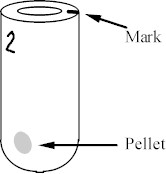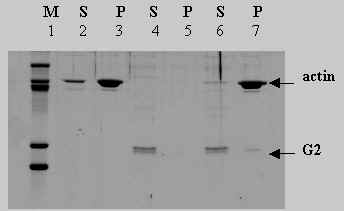|
Actin:Actin-Binding
Protein Co-sedimentation
Assay
|
|
This
method is useful to determine if a protein binds to either G- or to
F-actin. Actin reversibly
polymerizes from G-actin to F-actin.
This transformation can be accomplished in vitro by adding salts to
G-actin. G-Actin requires ATP
to keep it stable.
Method
1.
Set up reactions in 2ml centrifuge tubes.
Include controls i.e. protein without actin, and actin without
protein. Mark the inside of
the tube, so that the position of the pellet can be predicted. This will
help extract the supernatant without disturbing the pellet.
|
|

|
|
|
| Example: |
G actin |
5mM |
|
Protein |
5mM |
|
10x
KME* |
50ml |
| and
make up to 500ml
with buffer G (see below).
*
This is the salt solution added to initiate polymerization
of actin as a 10x stock. Many
actin binding proteins are pH and/or Ca sensitive w.r.t. binding
actin. This can be
tested by altering the composition of the 10salt solution.
Some variants are shown below.
|
|
|
2.
Incubate at least 1 hour at room temp.
|
|
3.
Centrifuge at 100K in TL100.2 for
15mins at 20oC
|
|
4.
Remove supernatant and transfer to a clean eppendorf.
Then add 500ml
sample buffer.
|
|
5.
Add 500ml
sample buffer to pellet and allow to stand for 10 mins. Resuspend by
pipetting up and down, and transfer to a clean eppendorf.
|
|
6.
Wash the centrifuge tube by adding 500ml
buffer G (see below) then mix with pellet fraction.
|
|
7.
Boil samples for 5mins then load 10ml
on a gel.
|
|
|
| 10x KME pH6.5 |
10xKME pH8.0 |
10xKM pH6.5 |
| 0.1M
Imidazole |
0.1M
Tris |
0.1M
Imidazole |
| 500mM
KCl |
500mM
KCl |
500mM
KCl |
| 10mM
MgCl |
10mM
MgCl |
10mM
MgCl |
| 10mM
EGTA |
10mM
EGTA |
|
|
|
|
|
|
The
following is an example of a co-sediment assay.
G2 is a domain of gelsolin known to bind F-actin weakly.
|
|

|
|
Lane 1 are the
molecular weight markers. 2&3 are the sups and pellets of actin alone, 4 &5 are
the sups and pellets of G2 alone, 6 & 7 are the sups and pellets of
actin and G2 together. Note
that there is G2 in the pellet when
run with actin (lane7), but not in the absence of actin (lane5).
Also note that there is less actin in the sup with G2 (lane6)
than the sup of actin alone(lane2). This is because G2 stimulates
polymerization of actin.
|
Buffer G :-
|
|
Stock
|
per
litre
|
per
100 ml of 100x
|
|
|
|
|
|
2
mM Tris pH 8.0
|
1
M
|
2
ml
|
20ml
|
|
0.2
mM ATP
|
0.1
M
|
2
ml
|
20ml
|
|
0.5
mM DTT
|
dry
|
77
mg
|
0.77g
|
|
0.2
mM CaCl2
|
0.1
M
|
2
ml
|
*
|
|
0.002%
NaN3
|
dry
|
0.2
g
|
2g
|
| *
Add the 2mls of 0.1M Calcium after the 100x
buffer G is made up to 1 litre, as it precipitates the ATP if
added to the 100x buffer |
|
|
References:- |
